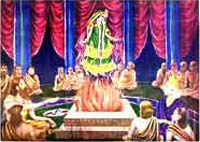There is a course called Vipassana (Art of Living) in India and other places in the world. I have been here once many years ago and I found it very enriching. I have decided to do it again this year. For all who know me, keeping dead silent for 10 days is going to be a torture but I am sure I will prevail. For those who wish to know more, go to http://www.dhamma.org/index.htm They also have a 10 days course which is held at St John's island. Imagine 10 days of no phone, no email, no radio, no TV, simple veg food, wake up call at 4:30 AM and bed time call @ 9:30 PM. Sounds like a perfect de-stress time.
The below text is based upon a talk given by Mr. S.N. Goenka in Berne, Switzerland
Everyone seeks peace and harmony, because these are what we lack in our lives. From time to time we all experience agitation, irritation, disharmony, suffering; and when one suffers from agitation, one does not keep this misery limited to oneself. One keeps distributing it to others as well. The agitation permeates the atmosphere around the miserable person. Everyone who comes into contact with him also becomes irritated, agitated. Certainly this is not the proper way to live. One ought to live at peace with oneself, and at peace with all others. After all, a human being is a social being. He has to live in society--to live and deal with others. How are we to live peacefully? How are we to remain harmonious with ourselves, and to maintain peace and harmony around us, so that others can also live peacefully and harmoniously?
One is agitated. To come out of the agitation, one has to know the basic reason for it, the cause of the suffering. If one investigates the problem, it will become clear that whenever one starts generating any negativity or defilement in the mind, one is bound to become agitated. A negativity in the mind, a mental defilement or impurity, cannot exist with peace and harmony.
How does one start generating negativity? Again, by investigating, it becomes clear. I become very unhappy when I find someone behaving in a way which I don't like, when I find something happening which I don't like. Unwanted things happen and I create tension within myself. Wanted things do not happen, some obstacles come in the way, and again I create tension within myself; I start tying knots within myself. And throughout life, unwanted things keep on happening, wanted things may or may not happen, and this process or reaction, of tying knots--Gordian knots--makes the entire mental and physical structure so tense, so full of negativity, that life becomes miserable.
Now one way to solve the problem is to arrange that nothing unwanted happens in my life and that everything keeps on happening exactly as I desire. i must develop such power, or somebody else must have the power and must come to my aid when I request him, that unwanted things do not happen and that everything I want happens. But this is not possible. There is no one in the world whose desires are always fulfilled, in whose life everything happens according to his wishes, without anything unwanted happening. Things keep on occurring that are contrary to our desires and wishes. So the question arises, how am I not to react blindly in the face of these things which I don't like? How not to create tension? How to remain peaceful and harmonious?
In India as well as in other countries, wise saintly persons of the past studied this problem--the problem of human suffering--and found a solution: if something unwanted happens and one starts to react by generating anger, fear or any negativity, then as soon as possible one should divert one's attention to something else. For example, get up, take a glass of water, start drinking--your anger will not multiply and you'll be coming out of anger. Or start counting: one, two, three, four. Or start repeating a word, or a phrase, or some mantra, perhaps the name of a deity or saintly person in whom you have devotion; the mind is diverted, and to some extent, you'll be out of the negativity, out of anger.
This solution was helpful: it worked. It still works. Practicing this, the mind feels free from agitation. In fact, however, the solution works only at the conscious level. Actually, by diverting the attention, one pushes the negativity deep into the unconscious, and on this level one continues to generate and multiply the same defilements. At the surface level there is a layer of peace and harmony, but in the depths of the mind there is a sleeping volcano of suppressed negativity which sooner or later will explode in violent eruption.
Other explorers of inner truth went still further in their search; and by experiencing the reality of mind and matter within themselves they recognized that diverting the attention is only running away from the problem. Escape is no solution: one must face the problem. Whenever a negativity arises in the mind, just observe it, face it. As soon as one starts observing any mental defilement, it begins to lose strength. Slowly it withers away and is uprooted.
A good solution: it avoids both extremes--suppression and free license. Keeping the negativity in the unconscious will not eradicate it; and allowing it to manifest in physical or vocal action will only create more problems. But if one just observes, then the defilement passes away, and one has eradicated that negativity, one is freed from the defilement.
This sounds wonderful, but is it really practical? For an average person, is it easy to face the defilement? When anger arises, it overpowers us so quickly that we don't even notice. Then overpowered by anger, we commit certain actions physically or vocally which are harmful to us and to others. Later, when the anger has passed, we start crying and repenting, begging pardon from this or that person or from God: 'Oh, I made a mistake, please excuse me!' But the next time we are in a similar situation, we again react in the same way. All that repenting does not help at all.
The difficulty is that I am not aware when a defilement starts. It begins deep in the unconscious level of the mind, and by the time it reaches the conscious level, it has gained so much strength that it overwhelms me, and I cannot observe it.
Then I must keep a private secretary with me, so that whenever anger starts, he says, 'Look master, anger is starting!' Since I cannot know when this anger will start, I must have three private secretaries for three shifts, around the clock! Suppose I can afford that, and the anger starts to arise. At once my secretary tells me, 'Oh, master, look--anger has started!' The first thing I will do is slap and abuse him: 'You fool! Do you think you are paid to teach me?' I am so overpowered by anger that no good advise will help.
Even supposing wisdom prevails and I do not slap him. Instead I say, 'Thank you very much. Now I must sit down and observe my anger.' Yet it is possible? As soon as I close my eyes and try to observe the anger, immediately the object of anger come into my mind--the person or incident because of which I become angry. Then I am not observing the anger itself. I am merely observing the external stimulus of the emotion. This will only serve to multiply the anger; this is no solution. It is very difficult to observe any abstract negativity, abstract emotion, divorced from the external object which aroused it.
However, one who reached the ultimate truth found a real solution. He discovered that whenever any defilement arises in the mind, simultaneously two things start happening at the physical level. One is that the breath loses its normal rhythm. We start breathing hard whenever a negativity comes into the mind. This is easy to observe. At subtler level, some kind of biochemical reaction starts within the body--some sensation. Every defilement will generate one sensation or another inside, in one part of the body or another.
This is a practical solution. An ordinary person cannot observe abstract defilements of the mind--abstract fear, anger, or passion. But with proper training and practice, it is very easy to observe respiration and bodily sensations--both of which are directly related to the mental defilements.
Respiration and sensation will help me in two ways. Firstly, they will be like my private secretaries. As soon as a defilement starts in my mind, my breath will lose its normality; it will start shouting, 'Look, something has gone wrong!' I cannot slap my breath; I have to accept the warning. Similarly the sensations tell me that something has gone wrong. Then having been warned, I start observing my respiration, my sensation, and I find very quickly that the defilement passes away.
This mental-physical phenomenon is like a coin with two sides. On the one side are whatever thoughts or emotions are arising in the mind. One the other side are the respiration and sensations in the body. Any thought or emotion, any mental defilement, manifests itself in the breath and the sensation of that moment. Thus, by observing the respiration or the sensation, I am in fact observing the mental defilement. Instead of running away from the problem, I am facing reality as it is. Then I shall find that the defilement loses its strength: it can no longer overpower me as it did in the past. If I persist, the defilement eventually disappears altogether, and I remain peaceful and happy.
In this way, the techniques of self-observation shows us reality in its two aspects, inner and outer. Previously, one always looked with open eyes, missing the inner truth. I always looked outside for the cause of my unhappiness; I always blamed and tried to change the reality outside. Being ignorant of the inner reality, I never understood that the cause of suffering lies within, in my own blind reactions toward pleasant and unpleasant sensations.
Now, with training, I can see the other side of the coin. I can be aware of my breathing and also of what is happening inside me. Whatever it is, breath or sensation, I learn just to observe it, without losing the balance of the mind. I stop reacting, stop multiplying my misery. Instead, I allow the defilement to manifest and pass away.
The more one practices this technique, the more quickly one will find one will come out of negativity. Gradually the mind becomes freed of the defilements; it becomes pure. A pure mind is always full of love--selfless love for all others; full of compassion for the failings and sufferings of others; full of joy at their success and happiness; full of equanimity in the face of any situation.
When one reaches this stage, the entire pattern of one's life starts changing. It is no longer possible to do anything vocally or physically which will disturb the peace and happiness of others. Instead, the balanced mind not only becomes peaceful in itself, but it helps others also to become peaceful. The atmosphere surrounding such a person will become permeated with peace and harmony, and this will start affecting others too.
By learning to remain balanced in the face of everything one experiences inside, one develops detachment towards all that one encounters in external situations as well. However, this detachment is not escapism or indifference to the problems of the world. A Vipassana meditator becomes more sensitive to the sufferings of others, and does his utmost to relieve their suffering in whatever way he can--not with any agitation but with a mind full of love, compassion and equanimity. He learns holy indifference--how to be fully committed, fully involved in helping others, while at the same time maintaining the balance of his mind. In this way he remains peaceful and happy, while working for the peace and happiness of others.
This is what the Buddha taught; an art of living. He never established or taught any religion, any 'ism'. He never instructed his followers to practice any rites or rituals, any blind or empty formalities. Instead, he taught just to observe nature as it is, by observing reality inside. Out of ignorance, one keeps reacting in a way which is harmful to oneself and to others. But when wisdom arises--the wisdom of observing the reality as it is--one come out of this habit of reaction. When one ceases to react blindly, then one is capable of real action--action proceeding from a balanced mind, a mind which sees and understands the truth. Such action can only be positive, creative, helpful to oneself and to others.
What is necessary, then, is to 'know thyself'--advice which every wise person has given. One must know oneself not just at the intellectual level, the level of ideas and theories. Nor does this mean to know just at the emotional or devotional level, simply accepting blindly what one has heard or read. Such knowledge is not enough. Rather one must know reality at the actual level.
One must experience directly the reality of this mental-physical phenomenon. This alone is what will help us to come out of defilements, out of suffering.
This direct experience of one's own reality, this techniques of self-observation, is what is called 'Vipassana' meditation. In the language of India in the time of the Buddha, passana meant seeing with open eyes, in the ordinary way; but Vipassana is observing things as they really are, not just as they seem to be. Apparent truth has to be penetrated, until one reaches the ultimate truth of the entire mental and physical structure. When one experiences this truth, then one learns to stop reacting blindly, to stop creating defilements--and naturally the old defilements gradually are eradicated. One come out of all the misery and experiences happiness.
There are three steps to the training which is given in a Vipassana meditation course Firstly, one must abstain from any action, physical or vocal, which disturbs the peace and harmony of others. One cannot work to liberate oneself from defilements in the mind while at the same time one continues to perform deeds of body and speech which only multiply those defilements. Therefore, a code of morality is the essential first step of the practice. One undertakes not to kill, not to steal, not to commit sexual misconduct, not to tell lies, and not to use intoxicants. By abstaining from such action, one allows the mind to quiet down sufficiently so that it can proceed with the task at hand.
The next step is to develop some mastery over this wild mind, by training it to remain fixed on a single object: the breath. One tries to keep one's attention for as long as possible on the respiration. This is not a breathing exercise: one does not regulate the breath. Instead one observes natural respiration as it is, as it comes in, as it goes out. In this way one further calms the mind so that it is no longer overpowered by violent negativities. At the same time, one is concentrating the mind, making it sharp and penetrating, capable of the work of insight.
These first two steps of living a moral life and controlling the mind are very necessary and beneficial in themselves; but they will lead to self-repression, unless one takes the third step - purifying the mind of defilements by developing insight into one's own nature. This is Vipassana: experiencing one's own reality, by the systematic and dispassionate observation of the ever-changing mind-matter phenomenon manifesting itself as sensation within oneself. This is the culmination of the teaching of the Buddha: self-purification by self-observation.
This can be practiced by one and all. Everyone faces the problem of suffering. it is a universal disease which requires a universal remedy--not a sectarian one. When one suffers from anger, it is not a Buddhist anger, Hindu anger, or Christian anger. Anger is anger. When one become agitated as a result of this anger, this agitation is not Christian, or Hindu, or Buddhist. The malady is universal. The remedy must also be universal.
Vipassana is such a remedy. No one will object to a code of living which respects the peace and harmony of others. No one will object to developing control over the mind. No one will object to developing insight into one's own reality, by which it is possible to free the mind of negativities. Vipassana is a universal path.
Observing reality as it is by observing the truth inside--this is knowing oneself at the actual, experiential level. As one practices, one keeps coming out of the misery of defilements. From the gross, external, apparent truth, one penetrates to the ultimate truth of mind and matter. Then one transcends that, and experiences a truth which is beyond mind and matter, beyond time and space, beyond the conditioned field of relativity: the truth of total liberation from all defilements, all impurities, all suffering. Whatever name one gives this ultimate truth, is irrelevant; it is the final goal of everyone.
May you all experience this ultimate truth. May all people come out of their defilements, their misery. May they enjoy real happiness, real peace, real harmony.
MAY ALL BEINGS BE HAPPY










